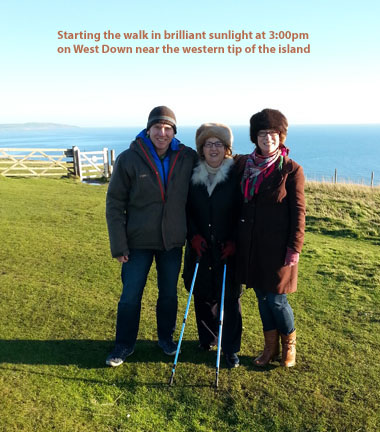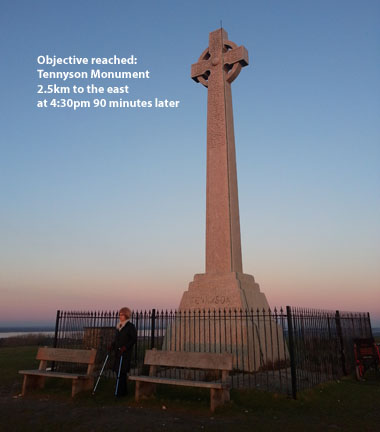| New Year 2014 | ||

| ||
|
Dear Friends
Many of our friends will have heard our sad news — that Patti is seriously unwell. This bulletin, written on Sunday 12 January 2014, will bring you up to date. The family were most concerned that radiotherapy could not start until 20 January. Since it appeared to us that the tumour had started recently and grown rapidly, a delay of three weeks would mean loss of valuable time in arresting its further growth. Dr Sharpe was due back on 30 December so we entered a combined request for an earlier date. On his return Doctor Sharpe expressed his horror at finding out about the delay and determined that he would find some way of starting Patti's treatment a fortnight earlier. The intervening week was an anxious time, but on Monday 6 January — Epiphany — Patti went in for her first treatment in the Oncology Centre at Southampton General Hospital. Meanwhile the family continued a frenzied series of meetings with our medical support team: GPs Simon Sherwin, Nikki Sheppard and Patti's own doctor Lesley Mayo; Penny, an occupational therapist; our district nursing team led by Diana; Maria from the Oakhaven Hospice in Lymington, and Fran from Oakhaven's Hospice-at-Home Service. On Friday 3 January Anna and John took Patti to see Oakhaven, which none of us had visited before. Patti met one of her golfing friends, Margaret Atkins, working as a volunteer on the reception desk. Maybe it was the surprise of seeing Margaret, but Patti's knees gave way; immediately three nurses caught her and settled her into a wheelchair. Fran took over and wheeled Patti round the hospice. Patti found the place peaceful and friendly. At three o'clock we all had tea with the day patients and met an old friend, Denis Skillicorn, who volunteers there once a week. It had been a full but comforting day. The following day we moved one of our twin beds downstairs into the music room for Patti, and a mattress from the loft was found for me. In the event the pair of us have slept downstairs only once so far. Patti's radiotherapy began on Monday 6 January. After the first session in the hospital we explored the Macmillan drop-in centre next to the hospital oncology department. The centre is a peaceful place, offering cups of tea and a variety of services; we were met on that Monday by Wendy, a volunteer, and on Tuesday by Ray, another volunteer. Everyone was very kind and understanding. Patti signed up for reflexology that Tuesday and aromatherapy on the final treatment day, Friday 17th. The radiotherapy went well. By the end of the first week, on 10 January — after five treatments — Patti was showing definite signs of improvement. Caroline and Anna accompanied Patti for her interim consultation with Dr Sharpe. Patti had asked to see her CT and MRI scans; that was arranged and copies provided on DVD to take home. All this time Patti wanted to be as active as possible. Our first free day was yesterday, Saturday 11 January. The weather was fine: a cloudless sky with sun forecast all day. So we took the ferry to Yarmouth: five adults, two dogs and a picnic lunch. From Yarmouth we drove to the Needles and continued up the National Trust road (No Cars)! to the top of West Down and parked on the grass high above the Needles Lighthouse. Patti walked with the rest of us all the way to the Tennyson Monument at the highest point of Tennyson Down — a distance of about a mile and a half. She was amazed and delighted to have made that objective in perfect visibility on such a glorious afternoon. We could see Portsmouth to the east and Ballard Down above Swanage to the west. As the sun set, giving way to a waxing gibbous moon, Dan wheeled Patti in our trusty Red Cross wheelchair back to the car. We returned on the five past six ferry to a sumptuous family dinner in front of a roaring fire the public bar of the East End Arms. |
||

| ||
 |
 |
|

| ||
| Alternative Therapies | ||

| ||
|
Many of our friends had suggested all sorts of alternative therapies, and we investigated several of those. The most promising had appeared to be laser treatment offered by various hospitals in America. We discussed that idea and resolved to follow it up. If the treatment outcome appeared likely to resolve the problem, Patti could choose whether it wold be worth any accompanying difficulties to go for it. We had enough money saved up to use if necessary. A decision about the usefulness of treatment would mean sending pictures of the CT and MRI scans to America; that was the reason for obtaining those from the hospital.
During the consultation with Dr Sharpe we raised this possibility. His response is illuminating. Patti's tumour is deep in the middle of the brain, in the part that controls the transfer of information between the left and right hemispheres. To attempt surgery there would be ill-advised; There would be grave danger of cutting vital connections or destroying key brain function. Moreover, it would be near-impossible to remove all of the tumour, so the operation would not even come close to achieving the intended outcome. Using a laser would be no different in principle from using a scalpel; in either case the task would be to attack this inaccessible and vital part of the brain, with attendant risk. Patti was welcome to explore other avenues, but Dr Sharpe was quite clear in his own mind that no good could come of it. On 23 December in his MDT meeting he had consulted with colleagues from all round the country by video-link, and all the surgeons had been unanimous in supporting his proposal for radiotherapy using 34 Gy over ten days (34/10) as had been found most efficacious in Nordic studies. In the discussions with Dr Sharpe, Patti asked about the genesis of the tumour: had it been around for a long time? In particular, had it been present (though much smaller) at the time an MRI scan had been taken in October 2011 to check her hearing function? The answer was no. The 2011 scan was re-examined, and it was confirmed that there had been no hint of a tumour then, two years earlier. Dr Sharpe said he thought it most likely the tumour had started to form and grow only three or four months ago. |
||

| ||
| Biographical note | ||

| ||
| Dr Sharpe trained and specialised in neuro-oncology at the Royal Marsden Hospital and subsequently here at Southampton. He is regarded as one of the most experienced and successful consultants here in Southampton, and is in demand as a conference speaker all round the world. The Royal Marsden is a world-leading cancer centre specialising in cancer diagnosis, treatment, research and education. The Southampton oncology unit is one of only twelve regional cancer centres in the UK, a leader in cancer research and treatment development. Southampton's Experimental Cancer Medicine Centre is at the heart of a continuous cycle of better care, therapy development and new knowledge as new therapies go from laboratory into the clinic, and back again for refinement. | ||

| ||